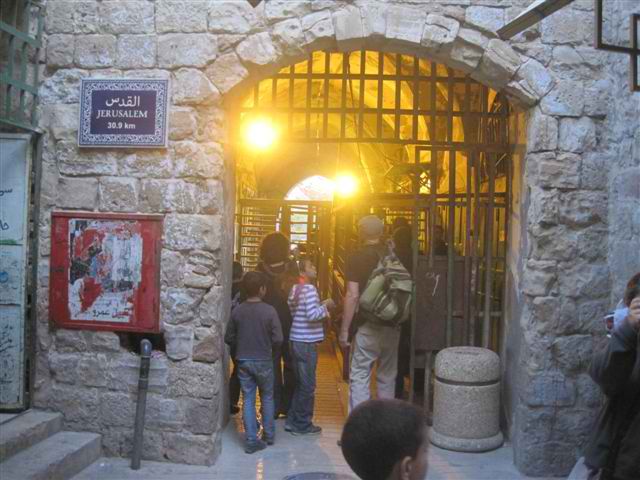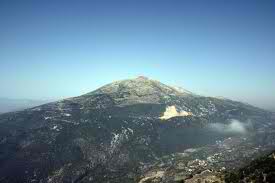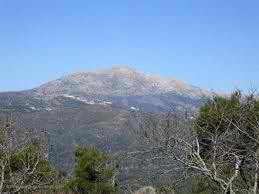It looks like you're using an Ad Blocker.
Please white-list or disable AboveTopSecret.com in your ad-blocking tool.
Thank you.
Some features of ATS will be disabled while you continue to use an ad-blocker.
4
share:
Everyone loves a good treasure story.
The Cave of Treasures
www.sacred-texts.com...
I had a good friend of mine ask me if I knew about the "Cave of Treasures". He and some other friends have been discussing it, and were certain that it was full of gold. Of course, I know of the story and realize that most of the information surrounding the cave is based on The First and Second Books of Adam and Eve, which most take to be a work of fiction, but it is still an interesting story.
The First Book of Adam and Eve
Chapter IV : Adam mourns over the changed conditions. Adam and Eve enter the Cave of Treasures.
The Cave of Treasures
The reason some people think that the cave is filled with gold is:
The Cave of Treasures
Others have a different take on it:
The Cave of Treasures
The Cave of Treasures
The Cave of Treasures
The Cave of Treasures
Here is The Cave of Treasures???
Is the Cave of the Patriarchs truly the Cave of Treasures?
It is a truly fascinating story to say the least. There is alot more information regarding the subject out there to read.
What does everyone think?
Is the "Cave of Treasures" just a myth derived from a fictional story, or could it be an oral history that was later documented and the cave's treasure awaits discovery?......or has it already been found?
www.abovetopsecret.com...
www.abovetopsecret.com...
The Cave of Treasures
www.sacred-texts.com...
I had a good friend of mine ask me if I knew about the "Cave of Treasures". He and some other friends have been discussing it, and were certain that it was full of gold. Of course, I know of the story and realize that most of the information surrounding the cave is based on The First and Second Books of Adam and Eve, which most take to be a work of fiction, but it is still an interesting story.
The First Book of Adam and Eve
Chapter IV : Adam mourns over the changed conditions. Adam and Eve enter the Cave of Treasures.
1 But Adam and Eve cried for having come out of the garden, their first home.
2 And indeed, when Adam looked at his flesh, that was altered, he cried bitterly, he and Eve, over what they had done. And they walked and went gently down into the Cave of Treasures.
The Cave of Treasures
The reason some people think that the cave is filled with gold is:
the famous Cave in which Adam and Eve were made to dwell by God after their expulsion from Paradise, and which by reason of the gold, and frankincense, and myrrh that was laid up in it, is commonly called "The Cave of Treasures"
The Cave of Treasures
Others have a different take on it:
The purpose of the Cave of Treasures is to relate the "succession of families from Adam to Christ." After the expulsion from Eden, Adam and Eve dwell in a cave on the top of one of the mountains near Paradise, which has been shut. The cave is called "Cave of Treasures" because Adam places therein gold, myrrh, and frankincense "from the skirts of the mountain of Paradise."
The Cave of Treasures
In rabbinic lore, obscure apocrypha and Jewish legends, when a patriarch dies, his family transports his body to the Cave of Treasures. There he is buried alongside his ancestors, in a secret tomb that is also a repository for sacred treasures. It is further hinted that the cave conceals an archive of sorts - one containing the most ancient “secrets of the Church.”
The Cave of Treasures
The Cave of Treasures
The Conflict of Adam and Eve is a fascinating pseudepigraphic
work that tells the story of the couple after they are cast out of the
Garden of Eden. After they left the garden, God commanded them
to live in a cave called the Cave of Treasures.
Specifically, it will demonstrate that the
“Cave of Treasures,” the place where Adam and Eve lived after
they were cast out of the garden, acted as a kind of temple for
Adam and Eve..
Instances in the story of The Conflict of Adam and Eve clearly
show that the Cave of Treasures functioned in similar ways to ancient
temples. It was similar to the temple typology in that (1) the
cave was oriented toward the four cardinal directions. (2) The cave
was located on the cosmic mountain. (3) The area around the temple
indicated successive ascent to heaven. (4) The cave was located
on separate, set-apart space. (5) God himself prepared the cave for
Adam and Eve. (6) The cave was the central, organizing unit
of Adam, Eve, and their posterity. (7) Adam and Eve were given
clothing in the cave. (8) Eve had to wash herself before entering
the cave. Adam was also washed for different reasons in the story.
(9) The cave was the burial place for Adam and his righteous sons.
The Cave of Treasures
The Cave of the Patriarchs is considered holy for the Jews, Christians and Muslims. It is a series of subterranean caves located in a complex called by Muslims the Ibrahimi Mosque or Sanctuary of Abraham. The name is either a reference to the layout of the burial chamber, or alternatively refers to the biblical couples, i.e.: cave of the tombs of couples. The compound is located in the ancient city of Hebron. The 3 religious groups maintain the same traditions that the site is the burial place of four Biblical couples: (1) Adam and Eve; (2) Abraham and Sarah; (3) Isaac and Rebekah; (4) Jacob and Leah. According to Midrashic sources the Cave of the Patriarchs also contains the head of Esau and according to some Islamic sources it is also the tomb of Joseph.
Here is The Cave of Treasures???
Is the Cave of the Patriarchs truly the Cave of Treasures?
It is a truly fascinating story to say the least. There is alot more information regarding the subject out there to read.
What does everyone think?
Is the "Cave of Treasures" just a myth derived from a fictional story, or could it be an oral history that was later documented and the cave's treasure awaits discovery?......or has it already been found?
www.abovetopsecret.com...
www.abovetopsecret.com...
edit on 11-12-2011 by isyeye because: (no reason given)
edit on
11-12-2011 by isyeye because: (no reason given)
edit on 11-12-2011 by isyeye because: (no reason given)
Why would Adam and Eve need gold? Everything was free back then not to mention being the only people on earth.
Originally posted by buster2010
Why would Adam and Eve need gold? Everything was free back then not to mention being the only people on earth.
My guess would be the same reason as any man.......his wife thought it looked good hanging around her neck...lol
reply to post by isyeye
Sounds like a story fabricated from the Israelites 40 years in the wilderness. All that desert heat must have melted the elders brains that participated in the Provocation.
It took God 2 weeks to get Israel out of Egypt, but it took him 40 years to get the Egypt out of Israel. Yeah, the dead hoarding riches like a dead pharoah definately sounds like it came out of their Egypt days. Not likely a true story, God has had a penchant for punishing selfish people that like to hoard riches like some greedy little rhesus monkey knicking dimes out of peoples purses. He even made the Israelites grind up all that gold they used to make the golden calf and he made them eat the gold dust in their bread. Pissing God off isnt even at the bottom of my list, its not something i want to do accidentally or otherwise.
Sounds like a story fabricated from the Israelites 40 years in the wilderness. All that desert heat must have melted the elders brains that participated in the Provocation.
It took God 2 weeks to get Israel out of Egypt, but it took him 40 years to get the Egypt out of Israel. Yeah, the dead hoarding riches like a dead pharoah definately sounds like it came out of their Egypt days. Not likely a true story, God has had a penchant for punishing selfish people that like to hoard riches like some greedy little rhesus monkey knicking dimes out of peoples purses. He even made the Israelites grind up all that gold they used to make the golden calf and he made them eat the gold dust in their bread. Pissing God off isnt even at the bottom of my list, its not something i want to do accidentally or otherwise.
Here is a picture of the Cave of Patriarchs, also known as the Cave of Machpelah
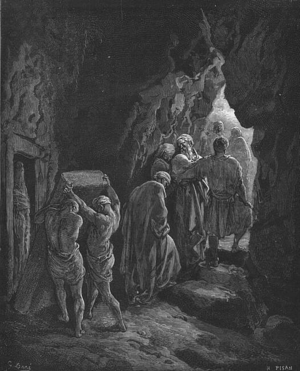
en.wikipedia.org...
The Abraham entrance into the cave system below


bibleatlas.org...
mak-pe'-la (ha-makhpelah, "the Machpelah"; to diploun, "the double"): The name of a piece of ground and of a cave purchased by Abraham as a place of sepulcher. The word is supposed to mean "double" and refers to the condition of the cave. It is translated "double cave" (to diploun spelaion) in the Septuagint in Genesis 23:17. The name is applied to the ground in Genesis 23:19; Genesis 49:30; Genesis 50:13, and to the cave in Genesis 23:9; Genesis 25:9. In Genesis 23:17 we have the phrase "the field of Ephron, which was in (the) Machpelah."
The Charam at Hebron, which present-day tradition, Christian, Jewish and Moslem, recognizes as built over the cave of Machpelah, is one of the most jealousy guarded sanctuaries in the world. Only on rare occasions and through the exercise of much political pressure have a few honored Christians been allowed to visit the spot.
The caves under the enclosure are not themselves generally accessible; the waqf have historically prevented access to the actual tombs out of respect for the dead. Only two entrances are known to exist, the most visible of which is located to the immediate southeast of Abraham's cenotaph on the inside of the southeastern section. This entrance is a narrow shaft covered by a decorative grate, which itself is covered by an elaborate dome. The other entrance is located to the southeast, near the mihrab, and is sealed by a large stone, and usually covered by prayer mats; this is very close to the location of the seventh step on the outside of the enclosure, beyond which the Mamelukes forbade Jews from approaching.
en.wikipedia.org...
The Abraham entrance into the cave system below

edit on 12-12-2011 by isyeye because: (no reason given)
Great research OP. I personally am fascinated with caves and have been to two ones which are considered holy, the first being on the greek island of
Patmos where supposedly John the Baptist wrote revelations, and the second being the Batu caves in KL.
Caves contain a beautiful mystique to them which cannot be denied, almost as if they are gateways to all the secret places of the Earth.
What ever your view of the Bible it is a very accurate historical manuscript and to actually discover a place which was written about 1000's of years ago is an experience like no other.
Caves contain a beautiful mystique to them which cannot be denied, almost as if they are gateways to all the secret places of the Earth.
What ever your view of the Bible it is a very accurate historical manuscript and to actually discover a place which was written about 1000's of years ago is an experience like no other.
www.bibleplaces.com...
The 14th-century canopy over the shaft leading to the burial caves
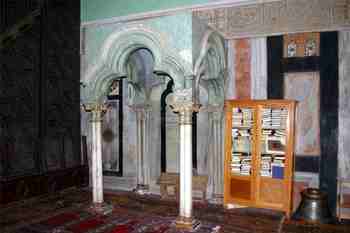
www.sacred-destinations.com...
Cenotaph of Abraham
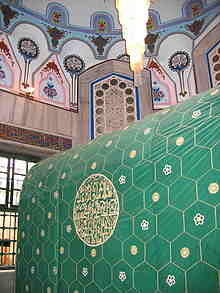
en.wikipedia.org...
Genesis 23 records the purchase by Abraham of a plot of ground in Hebron for a burial cave for his wife Sarah. In a deal that foreshadows many such other Middle Eastern deals, Abraham paid an outrageous 400 shekels of silver to Ephron the Hittite. Later Abraham, Isaac, Rebekah, Jacob and Leah would be buried here.
The 14th-century canopy over the shaft leading to the burial caves

www.sacred-destinations.com...
Cenotaph of Abraham

en.wikipedia.org...
edit on 12-12-2011 by isyeye because: (no reason given)
This is what jewishvirtuallibrary.org says about the site:
jewishvirtuallibrary.org
Here's biblehistory.com:
biblehistory.com
jewishvirtuallibrary.org
The Cave of Machpelah is the world's most ancient Jewish site and the second holiest place for the Jewish people, after Temple Mount in Jerusalem. The cave and the adjoining field were purchased—at full market price—by Abraham some 3700 years ago. Abraham, Isaac, Jacob, Sarah, Rebecca, and Leah are all later buried in the same Cave of Machpelah. These are considered the patriarchs and matriarchs of the Jewish people. The only one who is missing is Rachel, who was buried near Bethlehem where she died in childbirth.
The double cave, a mystery of thousands of years, was uncovered several years ago beneath the massive building, revealing artifacts from the Early Israelite Period (some 30 centuries ago). The structure was built during the Second Temple Period (about two thousand years ago) by Herod, King of Judea, providing a place for gatherings and Jewish prayers at the graves of the Patriarchs.
This uniquely impressive building is the only one that stands intact and still fulfills its original function after thousands of years. Foreign conquerors and invaders used the site for their own purposes, depending on their religious orientation: the Byzantines and Crusaders transformed it into a church and the Muslims rendered it a mosque. About 700 years ago, the Muslim Mamelukes conquered Hebron, declared the structure a mosque and forbade entry to Jews, who were not allowed past the seventh step on a staircase outside the building.
Upon the liberation of Hebron in 1967, the Chief Rabbi of the Israel Defense Forces, the late Major-General Rabbi Shlomo Goren, was the first Jew to enter the Cave of Machpelah. Since then, Jews have been struggling to regain their prayer rights at the site, still run by the Muslim Waqf (Religious Trust) that took control during the Arab conquest. Many restrictions are imposed on Jewish prayers and customs at the Tomb of the Patriarchs despite the site's significance, primacy and sanctity in Jewish heritage and history
Here's biblehistory.com:
biblehistory.com
Machpelah in Easton's Bible Dictionary portion; double cave, the cave which Abraham bought, together with the field in which it stood, from Ephron the Hittite, for a family burying-place (Gen. 23). It is one of those Bible localities about the identification of which there can be no doubt. It was on the slope of a hill on the east of Hebron, "before Mamre." Here were laid the bodies of Abraham and Sarah, Isaac and Rebekah, Jacob and Leah (Gen. 23:19; 25:9; 49:31; 50:13). Over the cave an ancient Christian church was erected, probably in the time of Justinian, the Roman emperor. This church has been converted into a Mohammedan mosque. The whole is surrounded by the el-Haram i.e., "the sacred enclosure," about 200 feet long, 115 broad, and of an average height of about 50. This building, from the immense size of some of its stones, and the manner in which they are fitted together, is supposed by some to have been erected in the days of David or of Solomon, while others ascribe it to the time of Herod. It is looked upon as the most ancient and finest relic of Jewish architecture. On the floor of the mosque are erected six large cenotaphs as monuments to the dead who are buried in the cave beneath. Between the cenotaphs of Isaac and Rebekah there is a circular opening in the floor into the cavern below, the cave of Machpelah. Here it may be that the body of Jacob, which was embalmed in Egypt, is still preserved (much older embalmed bodies have recently been found in the cave of Deir el-Bahari in Egypt, see PHARAOH ¯T0002923), though those of the others there buried may have long ago mouldered into dust. The interior of the mosque was visited by the Prince of Wales in 1862 by a special favour of the Mohammedan authorities. An interesting account of this visit is given in Dean Stanley's Lectures on the Jewish Church. It was also visited in 1866 by the Marquis of Bute, and in 1869 by the late Emperor (Frederick) of Germany, then the Crown Prince of Prussia. In 1881 it was visited by the two sons of the Prince of Wales, accompanied by Sir C. Wilson and others. (See Israel Quarterly Statement, October 1882).
Machpelah in Fausset's Bible Dictionary The tract containing the field and cave in the end of Ephron's field, which Abraham bought as his burying ground from Ephron and the sons of Heth (Genesis 23:9); his only possession in the land of promise. All ancient versions translated Machpelah "the double cave," from kaphal, "to divide or double". Either there were two entrances or two receptacles for bodies. Gesenius derives it from a root, "portion." A mosque now covers it. The sacred precinct (harem) is enclosed by a wall, the oldest in Israel. The masonry is more antique than the S.W. wall of the haram at Jerusalem; one stone is 38 ft. long, 3 1/4 ft. deep. The beveling is shallow, and at latest belongs to the age of Solomon; Jewish ancient tradition ascribes it to David. It lay near Hebron. (See HEBRON.) The sepulchers of Abraham, Sarah, Isaac, Rebekah, Jacob, and Leah are shown on the mosque floor; but the real sepulchers are in the cave below the floor; the cave opens to the S., and the bodies were laid with their heads to the N.
edit on 12-12-2011 by isyeye because: (no reason given)
This is a recent picture at the site from National Geographic
National Geographic
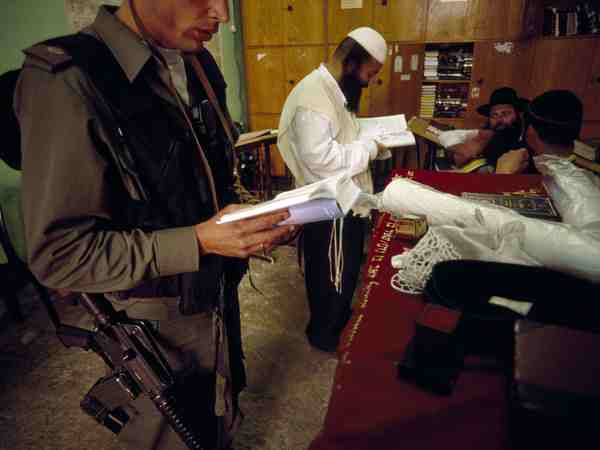
www.megalithic.co.uk...
National Geographic

www.megalithic.co.uk...
According to Midrash and other sources the Cave of the Patriarchs also contains the head of Esau, and according to some Islamic sources it is also the tomb of Joseph. Though the Bible has Joseph buried in Shechem (the present-day Palestinian city of Nablus), Jewish aggadic tradition conserved the idea that he wished to be interred at Hebron, and the Islamic version may reflect this. The Jewish apocryphal book The Testaments of the Twelve Patriarchs, also states that this is the burial place of Jacob's twelve sons.
Abraham's Marker
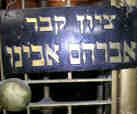
www.machpela.com...
The cenotaphs of Scriptural patriarchs, in the mosque at Hebron

www.yahwehsword.org...

www.machpela.com...
This is the main, central marker, tallest of the grave markers in the edifice. It is also the closest to the underground cave. Abraham was the herald of faith in the One G-d, the father of the Jewish Nation and an admired personality the world over. He purchased Ma'arat HaMachpela and transformed it into the first Jewish acquisition in the Land, and the burial place of the patriarchs and matriarchs. Once members of other faiths took control of the site over various periods, Abraham's marker, as well, was covered with Arabic inscriptions, and Jews are today prevented from entering his chamber. Over the monument is draped a gold-embroidered curtain, donated by an Indian prince.
The cenotaphs of Scriptural patriarchs, in the mosque at Hebron

www.yahwehsword.org...
TextAlready in A.D. 333-4 the manuscript known as the Bordeaux Pilgrim mentions the presence of a mausoleum (memoria), above the cave of Machpelah, square in shape and beautifully constructed of stone. St Jerome, a tireless visitor of the holy places, confirms the statement. Two centuries later a considerable change had occurred: Antoninus of Piacenza (570) describes his admiration for a basilica which at that period stood above the cave.
Seventy years later the tomb of the three patriarchs passed into the hands of the Mohammedans whose dominion extended to the whole of Palestine. But they do not seem, at least for a time, to have prevented Messianic followers from going to pray there, though, of course, the former church was transformed into a mosque.
further change occurred in 1099 when the Franks took possession of the country. The mosque was returned to use as a Christian sanctuary dedicated to St Abraham. This church was served at first by a college of canons governed by a prior. A little later it became a cathedral under a bishop. Pilgrims crowded to the spot and many of them have left descriptions of the building. In 1187 there was a further change of fortune and Saladin, the great Mohammedan leader, the conqueror of the Franks, hastened to reoccupy the tomb of Abraham, venerated by the followers of Allah both as a prophet and the father of Ishmael, the ancestor of the Arabs. Access to the cave was not, however, forbidden to Messianic followers, at least according to the account drawn up by the Dominican Buchard (1283) who seems to have been given permission to spend a whole night in prayer by the tomb of the patriarchs. But in 1583 the Franciscan Ouaresimus notes with understandable grief the formal prohibition of all visits to the crypt. In fact from the sixteenth century down to the middle of the nineteenth no Christian was able to enter the cave of Machpelah.
In 1843, however, Dr Frankel succeeded in bribing the keepers of the underground sanctuary; he went down into the crypt and was able to observe the sarcophagi, each of which, bearing the name of a patriarch cut in Hebrew and Arabic letters, was covered in damask.
The last European investigation, carried out with uncommon daring, took place in 1859. Its hero was the Piedmontese architect Pierotti, at that time an official of the municipality of Yerusalem. Disguised as an Arab and with the complicity of the keeper of the tomb, purchased for a considerable sum, he managed to effect an attempted descent. According to his account the principal staircase goes down from the vestibule of the mosque. It comes out above, and nearly in the centre, of the ancient cave. It is hewn out of the rock and is only a little over two feet wide. It terminates in a large iron grill heavily padlocked. The keeper, despite the large bribe paid by Pierotti, only allowed him to go down five steps. From this point, in the light of the lamps 7 which light up the tomb continuously, he could make out some sarcophagi of white stone. All this, it must be admitted, provides but scanty information.
Since then there have been several attempts to go down into the tomb which, despite preparation by official and diplomatic channels, have been fruitless.
7 These lamps are let down by a cord from the floor of the mosque built above the cave, through six openings no more than a foot wide The oil for the lamps is paid for by gifts coming from all over the Islamic world.
edit on 12-12-2011 by isyeye because: (no reason given)
A picture of the inside of the cave
www.hebron.com...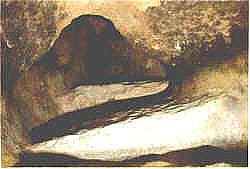
Map of a section of the underground area of Ma'arat Hamnachipela
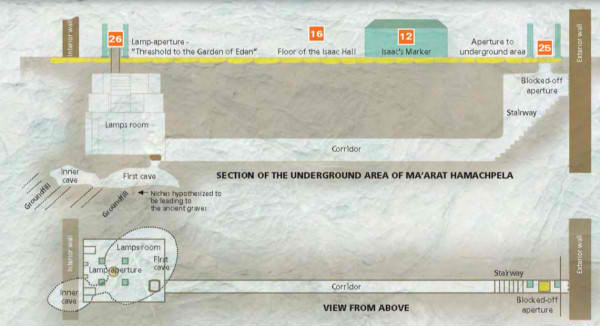
This is what is standing above the cave
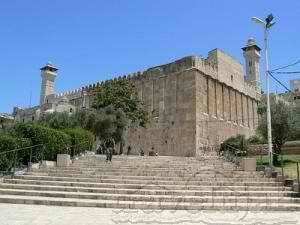
www.travelujah.com...
www.hebron.com...

Map of a section of the underground area of Ma'arat Hamnachipela

This is what is standing above the cave

www.travelujah.com...
Known by a number of names including the Al-Haram Al Ibrahimi al Kahalil (the Sanctuary of Ibrahim, the friend), the outside walls of the Machpela cave visible today are at least 2000 years old and were likely constructed by King Herod who also built what today is known as the Western Wall in Jerusalem. the massive misptue has a 20 meter high wall with the lower part dating from the time of Herod while the main part was formerly a Crusader ChurchThe Machpela cave is the best kept structure built by Herod still standing and for that reason alone it is of particular significance. Another structural feature of note are the spectacularly painted Crusader ceilings inside the building, very detailed and of high artistic quality. Two minarets, added during the period of the Mareluks, remain. As the place of King David's anointment and the burial of the patriarchs, the sanctuary is regarded as holy to Jews, Christians and Muslim.
edit on 12-12-2011 by isyeye because: (no reason given)
Here is some more text from the First Book of Adam and Eve concerning gold:
www.sacred-texts.com...
www.israel-a-history-of.com...
www.sacred-texts.com...
AFTER these things God said unto Adam, "Thou didst ask of Me something from the garden, to be comforted therewith, and I have given thee these three tokens as a consolation to thee; that thou trust in Me and in My covenant with thee.
2 "For I will come and save thee; and kings shall bring me when in the flesh, gold, incense and myrrh; gold as a token of My kingdom; incense as a token of My divinity; and myrrh as a token of My suffering and of My death.
3 "But, O Adam, put these by thee in the cave; the gold that it may shed light over thee by night; the incense, that thou smell its sweet savour; and the myrrh, to comfort thee in thy sorrow."
4 When Adam heard these words from God, he worshipped
before Him. He and Eve worshipped Him and gave Him thanks, because He had dealt mercifully with them.
5 Then God commanded the three angels, Michael, Gabriel and Raphael, each to bring what he had brought, and give it to Adam. And they did so, one by one.
6 And God commanded Suriyel and Salathiel to bear up Adam and Eve, and bring them down from the top of the high mountain, and to take them to the Cave of Treasures.
7 There they laid the gold on the south side of the cave, the incense on the eastern side, and the myrrh on the western side. For the mouth of the cave was on the north side.
8 The angels then comforted Adam and Eve, and departed.
9 The gold was seventy rods; the incense, twelve pounds; and the myrrh, three pounds.
10 These remained by Adam in the House of Treasures; therefore was it called "of concealment." But other interpreters say it was called the "Cave of Treasures," by reason of the bodies of righteous men that were in it.
11 These three things did God give to Adam, on the third day after he had come out of the garden, in token of the three days the Lord should remain in the heart of the earth.
12 And these three things, as they continued with Adam in the cave, gave him light by night; and by day they gave him a little relief from his sorrow..
www.israel-a-history-of.com...
The name of the first river is the Pishon River (v.11). It is said to have "flown around the whole of the land of Havilah, where there is gold." The second river is called the Gihon River. The Gihon is said to have flowed around the land of Cush. Cush is a controversial interpretation of the Hebrew word.
The region of Havilah has an interesting place in the Bible. Genesis 10:7 lists one of Cush's son's name as Havilah, as well as a son of Joktan in Genesis 10:29. Cush was a descendant of Ham, and Joktan of Shem.
Havilah, believed to mean Sandland, possessed an abundance of gold and precious stones and substances. Surely Adam and Eve spent time exploring this rich and extravagant land. Havilah had made quite an impression on the descendants of Adam. Havilah is later said to have been where Ishmael settled (Gen. 25:18). Ishmael is said to have settled from "Havilah to Shur, which is east of Egypt".
The Christian Geology Center has put out an interesting study in which these stones are critical in helping locate the Biblical Garden of Eden. Genesis 2:11-12 describe the land of Havilah.
"The name of the first is Pishon; it flows around the whole land of Havilah, where there is gold. And the gold of that land is good; the bdellium and onyx stone are there."
edit on 12-12-2011 by isyeye because: (no reason given)
...even more information about Adam and Eve and gold:
onenessbecomesus.com...
www.thedeathandresurection.com...
onenessbecomesus.com...
Apocrypha Chap. LXXIII. The betrothal of Adam and Eve.
“THEN God looked upon the words of Adam that they were true, and that he could
long await His order, respecting the counsel of Satan.
2: And God approved Adam in what he had thought concerning this, and in the prayer
he had offered in His presence; and the Word of God came unto Adam and said to him,
"O Adam, if only thou hast had this caution at first, ere thou earnest out of the
garden into this land!"
3: After that, God sent His angel who had brought gold, and the angel who had
brought incense, and the angel who had brought myrrh to Adam, that they should
inform him respecting his wedding Eve. 4: Then those angels said to Adam, "Take the
gold and give it to Eve as a wedding gift, and betroth her; then give her some incense
and myrrh as a present; and be ye, thou and she, one flesh." 5 Adam hearkened to the
angels, and took the gold and put it into Eve's bosom in her garment; and bethrothed
her with his hand.
www.thedeathandresurection.com...
This is testimony from “The Book of Adam and Eve” which appears to be a
prophecy.
Chapter XXI.
7 "Therefore, 0 my sons, set your hearts on your own selves, and keep the commandment
of God which is with you. And when you go from this holy mountain, into a strange land
which ye know not, take with you the body of our father Adam, and with it these three
precious gifts and offerings, namely, the gold, the incense, and the myrrh; and let them be
in the place where the body of our father Adam shall lay...
edit on 12-12-2011 by isyeye because: (no reason given)
whispersofthespirit.com...
en.wikipedia.org...
Let us look at these three gifts separately and see what significance they hold. Gold in the Bible has always stood for divinity, that which is like God. It should not surprise us then to learn that gold is mentioned from beginning to end in the Bible. Just as God has always been, gold appears at the beginning of the Creation in the Garden of Eden. “The name of the first (river) is Pishon; it flows around the whole land of Havilah, where there is gold. The gold of that land is good” (Genesis 2:11-12). And it is what the New Jerusalem is made of at the end of this Creation. “The material of the wall was jasper; and the city was pure gold, like clear glass. And the twelve gates were twelve pearls; each one of the gates was a single pearl. And the street of the city was pure gold, like transparent glass” (Revelation 21:18,21).
en.wikipedia.org...
Details about the three of Joktan's sons, Sheba, Ophir and Havilah, were preserved in a tradition known in divergent forms from three pre-Islamic Arabic and Ethiopic sources: the Kitab al-Magall (part of Clementine literature), the Cave of Treasures, and the Conflict of Adam and Eve with Satan.
The Kitab al-Magall states that in the days of Reu, a king of Saba (Sheba) named "Pharoah" annexed Ophir and Havilah to his kingdom, and "built Ophir with stones of gold, for the stones of its mountains are pure gold."
In the Cave of Treasures, this appears as: "And the children of Ophir, that is, Send, appointed to be their king Lophoron, who built Ophir with stones of gold; now, all the stones that are in Ophir are of gold."
The version in the Conflict of Adam and Eve says: "Phar’an reigned over the children of Saphir [Ophir], and built the city of Saphir with stones of gold; and that is the land of Sarania, and because of these stones of gold, they say that the mountains of that country and the stones thereof are all of gold."
edit on 12-12-2011 by isyeye because: (no reason given)
...and of course there is the theory by Sitchin with Aliens / the Annunaki and Nibiru for all the alien conspiracy people:
www.sitchin.com...
www.sitchin.com...
They know that the biblical verses dealing with the fashioning of The Adam are condensed renderings of much much more detailed Sumerian and Akkadian texts, found inscribed on clay tablets, in which the role of the Elohim in Genesis is performed by the Anunnaki – “Those Who From Heaven to Earth Came.”
As detailed in my books, beginning with The 12th Planet (1976) and even more so in Genesis Revisited and The Cosmic Code, the Anunnaki came to Earth some 450,000 years ago from the planet Nibiru – a member of our own solar system whose great orbit brings it to our part of the heavens once every 3,600 years. They came here in need of gold, with which to protect their dwindling atmosphere. Exhausted and in need of help in mining the gold, their chief scientist Enki suggested that they use their genetic knowledge to create the needed Primitive Workers. When the other leaders of the Anunnaki asked: How can you create a new being? He answered:
"The being that we need already exists;
all that we have to do is put our mark on it.”
The time was some 300,000 years ago.
www.showcaves.com...
adamandevecave.com...
The Cave of Treasures is a mystic place said to be a necropolis containing the bodies of the Biblical patriarchs. When a patriarch dies his family transports his body to the Cave of Treasures, where he is buried alongside his ancestors. This secret tomb is also a repository for sacred treasures. Further the cave conceals an archive of the most ancient secrets of the Church.
The cave is described in an old Syriac text, written by Ephraim the Syrian, but also mentioned in obscure apocrypha and Jewish legends. There is some confusion as the text of Ephraim as he speaks of the cave as beeing inside paradise, but later in the same text after Adam has been expelled from paradise (outside) he is buried in the cave. Adam is telling his son Seth to bury him in the Cave of Treasures on the mountain, which Seth later does.
As this is a mystical cave it is not sure if there is a corresponding real place. There are various examples of early texts describing locations which were later found, for example Troj or the place where the Arch of Noah stranded. The location of the Cave of Treasures was often connected with the underground cities found at Kaymalki and Derinkuyu, or Rennes-le-Chateau. It is decribed beeing located on Mount Kardo, the mountain of Rennes-le-Chateau is called Mount Cardou. And there is a real place in Hebron, called Ma'arat HaMachpelah which is also said to be the burial place of Adam, Eve, Abraham and many other patriarchs.
adamandevecave.com...
Adam and Eve lived on bread and wine in Paradise, and Melchisedek administered bread and wine to Abraham, according to the command of Methuselah, and so foreshadowed the institution of the Sacrament. The Cave of Treasures, with the gold, frankincense and myrrh which Adam collected in it, symbolized not only the Temple, or house of prayer, but the cave in which the Magi presented their gifts to Christ. Adam was the first priest, and was present when Cain and Abel made their offerings, and the lamp which he placed by the side of Abel’s body in the Cave of Treasures was the prototype of the sanctuary lamp. Adam’s body was buried in the Cave of Treasures, which became a family mausoleum, for several of his sons and descendants were also buried there. Noah took Adam’s body from the Cave and carried it into Noah’s Ark, and it was in due course brought to Jerusalem by him, and deposited in the opening in the earth which the earth itself made to receive it. There it remained until the Cross of Christ was set up above it on Golgotha, and then, when Longinus pierced our Lord’s side, the blood and water flowed down into the place where Adam was. The blood gave him life, and he was baptized by the water.
edit on 12-12-2011 by isyeye because: (no reason given)
Here are more references to the cave and the mountain above:
THE SONS OF GOD AND THE DAUGHTERS OF MEN.
Notes from the Books of Ysrael. From Hebrew Myths:
The Book of Genesis By Robert Graves and Raphael Patai
www.sherryshriner.com...
6. The Mount of God, where certain pious Sethites lived near the "Cave of Treasure,"at the Gates of Paradise, will have been El's holy Mount Saphon, not Hermon. hills of ermon?
Mount Aqraa / Mount Zaphon
EL is the supreme creator god of the Canaanites who lives with the other gods on Mount Zaphon (similar to Mount Olympus of the Greeks but located at the mouth of the Orontes river near the border between Turkey and Syria).www.biblicalheritage.org...
Mount Aqraʻ ( ǧabal al-Aqraʻ ); also known as Zaphon in the Bible, and Mount Casius to the Greeks) is a mountain located near the mouth of the Orontes River on the Syrian-Turkish border around north of Ugarit. wdict.net...
edit on 12-12-2011 by isyeye because: (no reason given)
new topics
-
Tesla Cybertruck Explodes in Front of Trump Hotel in Las Vegas
Mainstream News: 3 hours ago -
Maybe they didn't get away with it: The Lincoln-Kennedy assassination parallels. 7 sentences long.
History: 5 hours ago -
Ukraine halts transit of Russian gas to Europe after a prewar deal expired
Political Conspiracies: 9 hours ago -
Welp...Happy New Year!!
General Chit Chat: 11 hours ago
top topics
-
Vehicle Strikes people in New Orleans
Mainstream News: 13 hours ago, 23 flags -
Tesla Cybertruck Explodes in Front of Trump Hotel in Las Vegas
Mainstream News: 3 hours ago, 13 flags -
Ukraine halts transit of Russian gas to Europe after a prewar deal expired
Political Conspiracies: 9 hours ago, 9 flags -
Welp...Happy New Year!!
General Chit Chat: 11 hours ago, 7 flags -
The Hand that Rocks the Cradle - Labour Plans “diversities of our society” Curriculum Change
Regional Politics: 13 hours ago, 6 flags -
Maybe they didn't get away with it: The Lincoln-Kennedy assassination parallels. 7 sentences long.
History: 5 hours ago, 4 flags
active topics
-
Vehicle Strikes people in New Orleans
Mainstream News • 216 • : marg6043 -
Can someone 'splain me like I'm 5. Blockchain?
Science & Technology • 98 • : TzarChasm -
Tesla Cybertruck Explodes in Front of Trump Hotel in Las Vegas
Mainstream News • 22 • : marg6043 -
Ukraine halts transit of Russian gas to Europe after a prewar deal expired
Political Conspiracies • 101 • : 38181 -
Happy New Year from Aussie
General Chit Chat • 23 • : bally001 -
Get Ready - Here comes the Bird Flu Pandemic - Millions are Notified
Diseases and Pandemics • 64 • : cherokeetroy -
Strange fog all over the northern hemisphere
General Conspiracies • 40 • : annonentity -
Maybe they didn't get away with it: The Lincoln-Kennedy assassination parallels. 7 sentences long.
History • 8 • : Dalamax -
-@TH3WH17ERABB17- -Q- ---TIME TO SHOW THE WORLD--- -Part- --44--
Dissecting Disinformation • 3878 • : xuenchen -
I dont understand what i just witnessed
Social Issues and Civil Unrest • 27 • : Oldcarpy2
4

